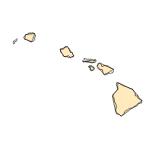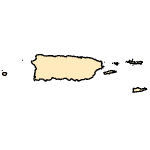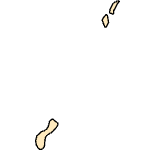Morone americana × saxatilis
(White Perch × Striped Bass)
Fishes
Native Hybrid |
|
Common name: White Perch × Striped Bass
Identification: Kerby (1979); Setzler et al. (1980); Page and Burr (1991).
Native Range: None; artificial hybrid.



|

Alaska |

Hawaii |

Puerto Rico &
Virgin Islands |

Guam Saipan |
Hydrologic Unit Codes (HUCs) Explained
Interactive maps: Point Distribution Maps
Nonindigenous Occurrences:
Table 1. States with nonindigenous occurrences, the earliest and latest observations in each state, and the tally and names of HUCs with observations†. Names and dates are hyperlinked to their relevant specimen records. The list of references for all nonindigenous occurrences of Morone americana × saxatilis are found here.
Table last updated 12/11/2025
† Populations may not be currently present.
* HUCs are not listed for states where the observation(s) cannot be approximated to a HUC (e.g. state centroids or Canadian provinces).
Means of Introduction: Intentionally stocked for sportfishing by the Delaware Division of Fish and Wildlife.
Status: Maintained by stocking.
Impact of Introduction: The impacts of this species are currently unknown, as no studies have been done to determine how it has affected ecosystems in the invaded range. The absence of data does not equate to lack of effects. It does, however, mean that research is required to evaluate effects before conclusions can be made.
References: (click for full references)
Page, L. M., and B. M. Burr. 1991. A field guide to freshwater fishes of North America north of Mexico. The Peterson Field Guide Series, volume 42. Houghton Mifflin Company, Boston, MA.
Raasch, M. S., and V. L. Altemus, Sr. 1991. Delaware's freshwater and brackish water fishes - a popular account. Delaware State College for the Study of Del-Mar-Va Habitats and the Society of Natural History of Delaware. 166 pp.
Other Resources:
Fact Sheet for Morone americana - USGS Nonindigenous Aquatic Species Database
Fact Sheet for Morone saxatilis - USGS Nonindigenous Aquatic Species Database
Author:
Fuller, P.
Revision Date: 5/9/2019
Peer Review Date: 12/4/2013
Citation Information:
Fuller, P., 2025, Morone americana × saxatilis: U.S. Geological Survey, Nonindigenous Aquatic Species Database, Gainesville, FL, https://nas.er.usgs.gov/queries/FactSheet.aspx?speciesID=778, Revision Date: 5/9/2019, Peer Review Date: 12/4/2013, Access Date: 12/12/2025
This information is preliminary or provisional and is subject to revision. It is being provided to meet the need for timely best science. The information has not received final approval by the U.S. Geological Survey (USGS) and is provided on the condition that neither the USGS nor the U.S. Government shall be held liable for any damages resulting from the authorized or unauthorized use of the information.